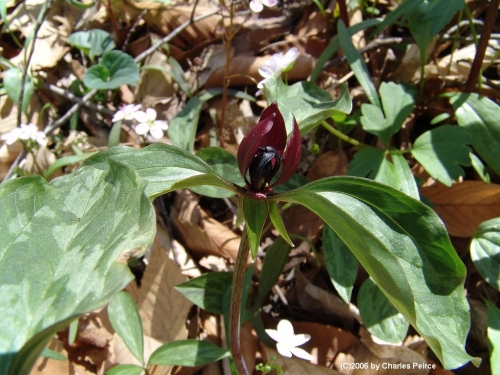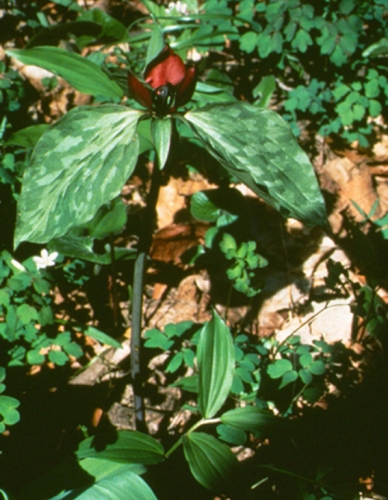Plants and Animals
Trillium recurvatum Prairie trillium
Key Characteristics
Medium-sized forb (40 cm) of rich woods; leaves broadly oval (3-6 cm wide) with distinct petioles, strongly mottled; flowers sessile, dark red to purple.
Status and Rank
US Status: No Status/Not Listed
State Status: SC - Special Concern (rare or uncertain; not legally protected)
Global Rank: G5 - Secure
State Rank: S2S3 - Rank is uncertain, ranging from imperiled to vulnerable
Occurrences
| County | Number of Occurrences | Year Last Observed |
|---|---|---|
| Berrien | 42 | 2022 |
| Cass | 5 | 2019 |
| Mackinac | 1 | 2018 |
| Wayne | 1 | 1905 |
Information is summarized from MNFI's database of rare species and community occurrences. Data may not reflect true distribution since much of the state has not been thoroughly surveyed.
Habitat
Prairie trillium is found in southwestern Lower Michigan floodplains and mesic forests, especially moist ravines, rich moist woods and bluffs and is most frequent on limestone derived soils.
Natural Community Types
For each species, lists of natural communities were derived from review of the nearly 6,500 element occurrences in the MNFI database, in addition to herbarium label data for some taxa. In most cases, at least one specimen record exists for each listed natural community. For certain taxa, especially poorly collected or extirpated species of prairie and savanna habitats, natural community lists were derived from inferences from collection sites and habitat preferences in immediately adjacent states (particularly Indiana and Illinois). Natural communities are not listed for those species documented only from altered or ruderal habitats in Michigan, especially for taxa that occur in a variety of habitats outside of the state.
Natural communities are not listed in order of frequency of occurrence, but are rather derived from the full set of natural communities, organized by Ecological Group. In many cases, the general habitat descriptions should provide greater clarity and direction to the surveyor. In future versions of the Rare Species Explorer, we hope to incorporate natural community fidelity ranks for each taxon.
Associated Plants
Silver maple, green ash, red maple, black walnut, hackberry, black maple, sugar maple, beech, Ohio buckeye, box elder, black ash, black willow, cottonwood, swamp white oak, sycamore, spice bush, redbud, paw paw, Kentucky coffee tree, red mulberry, wahoo, Virginia blue-bells, common trillium, red trillium, stinging nettle, poison ivy, moneywort, Canada moonseed, wild ginger, skunk cabbage, honewort, kidney-leaved buttercup, false mermaid, rough bedstraw, mayapple, blue eyed Mary, and Canada goldenrod.
Management Recommendations
Conserve hydrology of river system and corresponding cyclical floodplain regime. Maintain healthy intact, mature floodplain forests and minimize forest fragmentation. Monitor and control invasive species, particularly garlic mustard and dame's rocket. When possible, leave large tracts of unharvested forests and allow natural processes to operate unhindered.
Survey Methods
Random meander search covers areas that appear likely to have rare taxa, based on habitat and the judgement of the investigator.
-
Meander search
-
Survey Period: From second week of April to fourth week of June
-
References
Survey References
- Elzinga, C.L., D.W. Salzer, and J.W. Willoughby. 1998. Measuring and Monitoring Plant Populations. The Nature Conservancy and Bureau of Land Management, Denver. BLM Technical Reference 1730-1. 477pp.
- Goff, G.F., G.A. Dawson, and J.J. Rochow. 1982. Site examination for Threatened and Endangered plant species. Environmental Management 6(4): 307-316
- Nelson, J.R. 1984. Rare Plant Field Survey Guidelines. In: J.P. Smith and R. York. Inventory of rare and endangered vascular plants of California. 3rd Ed. California Native Plant Society, Berkeley. 174pp.
- Nelson, J.R. 1986. Rare Plant Surveys: Techniques For Impact Assessment. Natural Areas Journal 5(3):18-30.
- Nelson, J.R. 1987. Rare Plant Surveys: Techniques for Impact Assessment. In: Conservation and management of rare and endangered plants. Ed. T.S. Elias. California Native Plant Society, Sacramento. 8pp.
Technical References
- Case, F.W., Jr. and R. B. Case. 1997. Trilliums. Timber Press, Portland. 285pp.
- Deam, C. C. 1940. Flora of Indiana. Department of Conservation, Indianapolis. 1236pp.
- Flora of North America Editorial Committee. 2002. Flora of North America, North of Mexico. Volume 26: Magnoliaphyta: Liliidae: Liliales and Orchidales. Oxford University Press, New York. 723pp.
- Gleason, H. A., and A. Cronquist. 1991. Manual of Vascular Plants of Northeastern United States and Adjacent Canada. Second edition. The New York Botanical Garden, Bronx. 910pp.
- Gray, A. 1950. Gray's Manual of Botany; eighth ed. Van Nostrand Reinghold, New York. 1632pp.
- Holmgren, N.H. 1998. Illustrated Companion to Gleason and Cronquist's Manual. Illustrations of the vascular plants of Northeastern United States and adjacent Canada. New York Botanical Garden, Bronx. 937pp.
- Mohlenbrock, R.H. 1986. Guide to the Vascular Flora of Illinois. Southern Illinois University Press, Carbondale. 507pp.
- Swink, F. and G. Wilhelm. 1994. Plants of the Chicago Region, 4th ed. Indiana Academy of Science, Indianapolis. 921pp.
- Voss, E. G. 1972. Michigan Flora. Part I. Gymnosperms and Monocots. Bulletin of the Cranbrook Institute of Science and University of Michigan Herbarium. 488pp.



